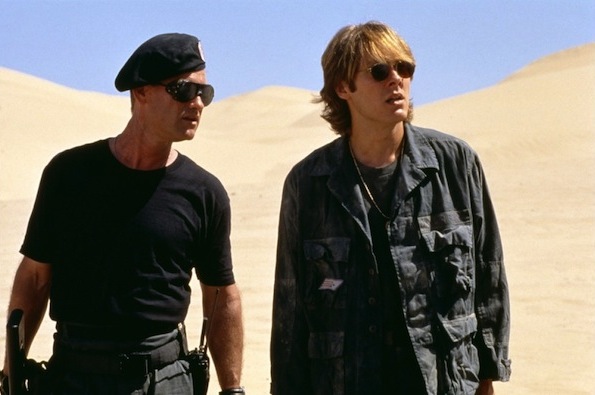Stargate
Written by Dean Devlin & Roland Emmerich
Directed by Roland Emmerich
Original release date: October 28, 1994
Mission briefing. We open in the north African desert in 8000 B.C. A giant pyramid-shaped spaceship lands, scaring the crap out of the loincloth-dressed humans—except for one who approaches the ship.
Cut to a dig in the same region in 1928. The head of the dig, Dr. Langford, arrives with his daughter Catherine to make an amazing discovery: a giant ring. They find some kind of fossil under it.
Cut to the present day. Dr. Daniel Jackson is giving a lecture on the subject of the pyramids. He theorizes that the pyramids were built long before they were believed to have been erected. His theory is considered laughable, and everyone walks out on him after deriding his theory.
One person who stayed for his whole lecture is Dr. Catherine Langford, now much older, obviously. She’s working for the U.S. Air Force and would like to offer him a job translating ancient hieroglyphs. This job can prove his theory right, according to her. He’s reluctant to take the job up to the point where she reminds him that he’s been evicted from his apartment and his grants have all run out. He’s got nowhere to go.
Two Air Force officers go to the O’Neil house. General West has reactivated Colonel Jack O’Neil. O’Neil himself barely notices they’re there. He’s been a mess since his son accidentally killed himself with O’Neil’s own gun.
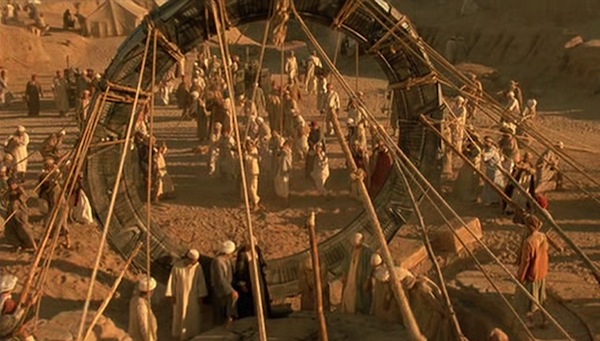
Jackson is brought to an Air Force facility deep inside Creek Mountain. They show him the coverstones, which have glyphs on them. Jackson trashes the translation that was done, and provides a new one, that ends with the word “stargate.”
O’Neil (who has a military haircut once again) comes in and announces that this is classified, and all information must go through the military. O’Neil explains to Langford that he’s been put in charge in case she succeeds.
Two weeks later, Jackson’s at a standstill—until he realizes that the glyphs on the outer track of the stone aren’t hieroglyphs, they’re renderings of constellations. Jackson is instructed to brief the military on what he’s found, and he tells General West that the six symbols are constellations that provide the six reference points you need for a location in three-dimensional space. But you need a seventh symbol: the point of origin. Jackson says it’s the symbol below the other six, but one of the other scientists says that symbol isn’t on “the device.”
At O’Neil’s nod, West authorizes Jackson to see the stargate, which Langford says is made of a mineral never seen on Earth. He’s blown away, and he finds a variation on the seventh symbol. West authorizes the seventh chevron to be added, and the technicians dial the sequence. The dialing programs shakes the crap out of the complex—which is why it’s in a missile silo—and after the seventh chevron is locked, a wormhole appears.
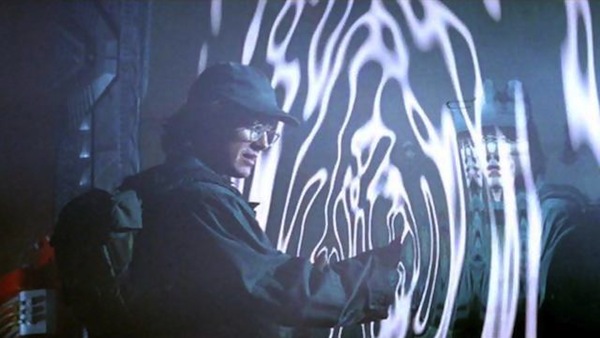
They send a MALP through the wormhole, clearing the silo. The telemetry from the MALP—which they somehow get instantaneously, even though it’s impossible for any kind of information to come that quickly over interstellar distances—says they’re in another galaxy “on the other side of the known universe.” Okay.
The wormhole closes, but they got lots of information from the MALP before it closed. There is a gate on the other side, but the symbols on it are different. That scotches West’s plan to send a reconnaissance team. If they can’t dial back, they’re screwed. However, Jackson says that he can dial back. O’Neil is skeptical, but West puts him on the team.
O’Neil then goes to where the fossil is being kept—the fossil that they’ve kept secret from Jackson.
Once again, the gate is dialed. O’Neil leads an eight-person team through, along with a bunch of equipment. Jackson goes through last.
They arrive in a darkened room, the trip through having caused everyone to freeze—they’re covered in ice. But it passes, and they move through the stone structure until they reach a desert. The building they were in looks like it’s straight out of ancient Egypt. Adding to that: the big-ass pyramid sticking up out of the ground. On the other hand, there are three moons in the sky.
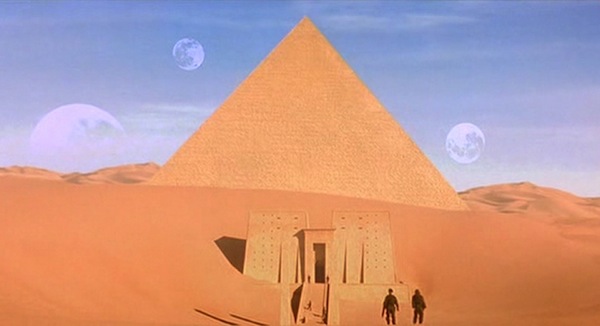
Jackson announces, to everyone’s chagrin, that he can’t realign the stargate because he can’t find a tablet like the coverstone to tell him what the order of coordinates is. O’Neil orders Kawalsky to set up a base camp—at which Jackson isn’t especially welcome—while O’Neil himself sets up the nuclear bomb he brought along just in case.
One of the airmen tosses Jackson’s briefcase at him, and it falls down a ravine. As Jackson is chasing down his books and notes, he sees animal tracks. He finds a four-legged beast that’s been domesticated, based on the harness. Jackson also spooks it, and it runs—with its reins wrapped around Jackson’s leg. After dragging him through the desert for a bit—with O’Neil, Kawalsky, and Brown going after him—they come across a mine filled with people. Brown reports that the readings indicate that they are mining the same material the stargate is made out of.
O’Neil instructs Jackson to talk to them (“You’re the linguist”). When they see the pendant that Langford gave him for luck, they all bow down.
One of the younger ones, Skaara, fetches Kasuf, one of the elders. Kasuf gives Jackson water. In exchange, he gives Kasuf a candy bar. Kasuf invites them back to their village. En route, one of the kids steals Jackson’s handkerchief, but Skaara gives it back.
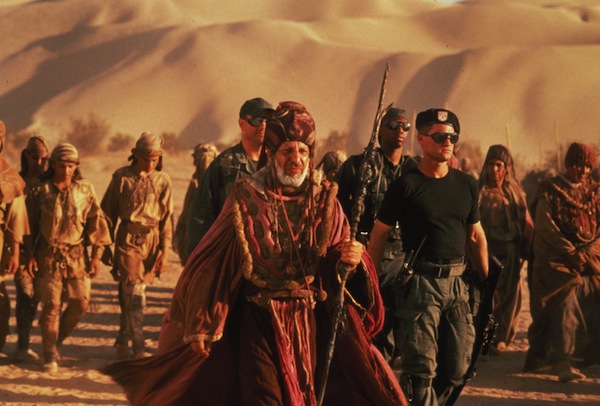
They arrive at the village and bow down before a larger version of the symbol on Jackson’s pendant. Jackson and O’Neil realize that they think Ra sent the four of them.
A horn sounds in the town, causing everyone to run about and close up the gates. Ferretti tries to contact O’Neil to say they have to abandon base camp thanks to the storm, but it doesn’t come through. O’Neil tries to go back, but the villagers won’t let them. There’s some serious miscommunication, which includes gunfire, before Skaara manages to show O’Neil the approaching sandstorm.
There’s a big feast that night, as various attempts at communication are made that only occasionally successful. Jackson tries to get Kasuf to show them what the symbols are for the stargate, but it becomes quickly apparent that writing is forbidden to these people.
And then Kasuf has Jackson whisked away to a tent, where he’s joined by Kasuf’s daughter, Sha’re, who tries to take her clothes off before he stops her. (Why, I have no idea.) She also at one point draws the symbol for Earth.
Ferretti and his group are holed up in the building that holds the stargate, waiting out the storm. Suddenly, a pyramid-shaped ship lands above them. Ferretti’s team are attacked one by one by Ra’s Jaffa. Ferretti himself is brought to Ra’s sarcophagus.
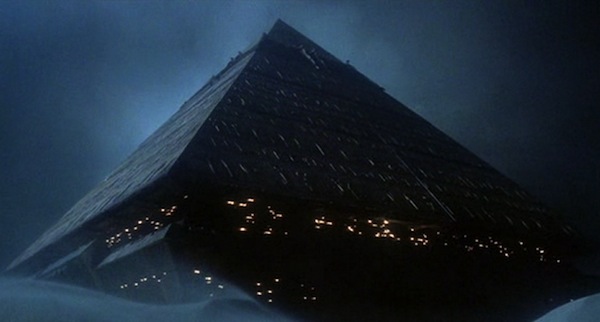
O’Neil bonds with Skaara over a lighter. Skaara attempts to smoke one of O’Neil’s cigarettes, impersonating all his mannerisms as well. But his actual first experience with a cigarette is nasty, and he stomps it out after one puff. However, O’Neil lets him keep the lighter. But when Skaara tries to touch O’Neil’s gun, he gets medieval on him, causing Skaara to run away scared.
Skaara takes the lighter to his friends and shows it off. O’Neil later goes to Skaara to ask where Jackson is. His attempts to communicate are a comedy of errors, but eventually he tracks Jackson to the catacombs where Sha’re took him. Jackson has found hieroglyphs that tell the story of this world. Ra was a member of a dying race that was looking for a way to extend its life. (We see a creature that looks a lot like an Unas.) Ra found Earth, took one human as a host, and set himself up as a leader. But there was an uprising, so he left through the stargate and started over on this world, where he outlawed reading and writing so that there would be no further rebellion.
Kawalsky finds a tablet that shows the six symbols needed to dial the gate, but the part with the point of origin has worn off. He can’t get them home.
The sandstorm has passed, so O’Neil, Kawasky, Brown, and Jackson head back to base camp. Skaara and several of his friends follow along. O’Neil and the gang are rather shocked to see the big-ass spaceship. Brown gives Jackson a pistol and the four of them head to the structure where they find stuff and spent shells lying around, but no sign of Ferretti or the others.
Brown is killed by a Jaffa’s staff weapon, and Kawalsky’s attacked as well. O’Neil drags Jackson down to the stargate and the bomb—but it’s been taken. Then the ring transporter operates and beams down another Jaffa who takes O’Neil and Jackson prisoner and bring them before Ra and his retinue of small children. Ra brings the bomb before them, accusing them of trying to kill him. For his part, Jackson is appalled by the bomb’s presence.
O’Neil tries to break free, and he manages to grab a staff weapon and kill one Jaffa. Jackson jumps in front of a staff weapon blast intended for O’Neil and is killed, while Ra is protected by the children, who all rush to stand in front of Ra when O’Neil aims his staff weapon at them. O’Neil can’t bring himself to fire on kids, and he’s disarmed, and tossed in a dungeon filled with waist-deep water, along with Kawalsky, Ferretti, and Freeman.
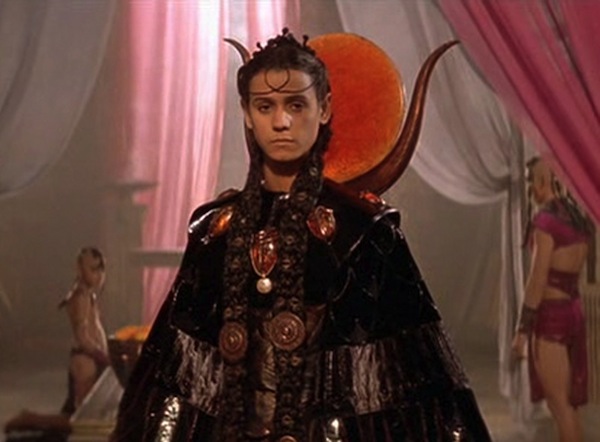
Ra releases gliders out of the pyramid and they attack the village, killing many. Skaara and his friends return to the village after rifling through the Air Force stuff in base camp. Skaara is devastated, and Kasuf says they should never have helped the strangers.
Jackson wakes up in a sarcophagus, stunned to find his wounds wholly healed. He confronts Ra, who is impressed with how far humanity has advanced. However, he feels that he created human civilization, and now he can destroy it. He’s going to enhance O’Neil’s bomb with the mineral they mine (naquadah) and send it through the gate back to Earth.
Ra calls an assembly to witness an execution. Even as he does, Sha’re tells Skaara and the others what Jackson told her about their people’s origins. Skaara goes back to the base camp and retrieves the weapons. Skaara uses O’Neil’s lighter to get Jackson’s attention so that, when Ra orders him to execute O’Neil, Kawalski, Ferretti, and Freeman, instead he turns his staff weapon on Ra’s Jaffa while Skaara and the others shoot into the sky, causing chaos. In the ensuing confusion, several people are killed, including Freeman, but O’Neil, Jackson, Kawalsky, Ferretti, Skaara, and Sha’re, among others, get away.
As they hide in a cave, O’Neil—partly at Jackson’s insistence—reveals the full mission. After Jackson figured out the stargate on this side, he and the rest of the team were to go back. O’Neil was to stay behind and detonate the bomb so that there’d be no threat to Earth. (Nice little suicide mission for the guy who’s lost his will to live.) But now Ra has the bomb and he’s going to use it to blow up Earth.
Ra uses a hand device to kill the Jaffa whom he blames for allowing O’Neil and the others to escape.
Jackson finds out, to his surprise, that he and Sha’re are married. So he figures, what the heck, and they consummate the marriage. The next day, Jackson sees Skaara drawing on the wall of the cave about their victory. From that drawing, he’s able to figure out what the point-of-origin symbol is.
A Jaffa comes to the village searching for O’Neil and the others, but Skaara helps bring him down. Kasuf is scared to death until he realizes that the Jaffa is just a normal human under his armor.
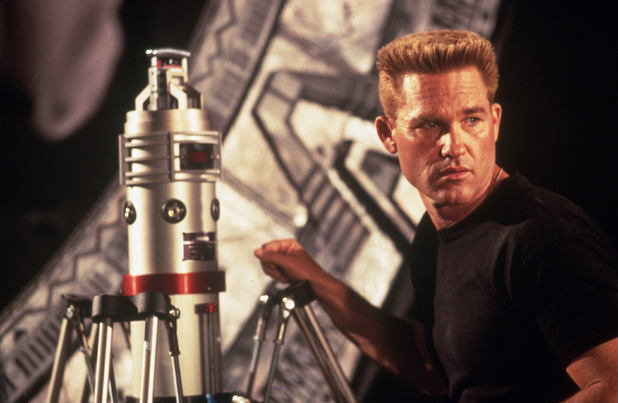
Posing as a caravan taking tribute to Ra, they lead an assault on the pyramid. O’Neil sets the bomb to go off in seven minutes. O’Neil tells Jackson that he’ll dismantle the gate on Earth while O’Neil makes sure the bomb goes off. But then a Jaffa attacks and kills Sha’re before O’Neil can kill him. When another Jaffa takes the rings down to send the bomb to Earth, Jackson steps into the matter stream with Sha’re’s corpse, bringing her to the sarcophagus to revive her. Meanwhile, O’Neil and the Jaffa get into a donnybrook, and Kawalsky, Ferretti, Skaara and the others are pinned down by Ra’s gliders. Kawalsky surrenders, but then Kasuf comes over the hill with the entire rest of the village, who overrun the two Jaffa who’d been piloting the gliders.
Jackson gets attacked by Ra, but manages to get away via the rings at the last second. Seeing victory slipping through his fingers, Ra preps his ship for takeoff. O’Neil can’t turn the bomb off, and then they both get the idea of using the rings to send the bomb to Ra’s ship before it can achieve escape velocity.
The natives are thrilled. They all cheer, Skaara and his friends also salute O’Neil, and Jackson and Sha’re kiss.

Jackson decides to stay behind with his new wife—it’s not like he had much of a life left on Earth—while O’Neil has decided that life might be worth living after all. The three Air Force officers head back through the gate back to Earth…
Can’t we just reverse the polarity? Devlin and Emmerich never really got the how-big-the-universe-is memo. Abydos (never named out loud in the story) is identified as being in another galaxy on the other side of the known universe (which is a meaningless phrase given the size and sprawl of the universe), which is so incalculably far away that the notion that they can track it with their little circle-on-a-map is laughable. (The TV show will correct this to having Abydos actually be very close to Earth, relatively speaking.)
Trivial matters. Several items that we’d also see in the TV series are seen here, though not named: Abydos, the MALP, the Jaffa, naquadah, a ha’tak, and of course the Goa’uld. The base with the stargate is Creek Mountain rather than Cheyenne Mountain, though it’s the same base as the TV show (with only minor design changes between movie and series). We also see a sarcophagus with its restorative powers (it resurrects both Jackson and Sha’re, and allows Ra to maintain his same youthful appearance for 10,000 years).
The flashbacks show that Ra’s prior form looks very much like the Unas, whom the TV show will establish as the previous hosts of the Goa’uld before they took on humans, but Ra’s death indicates that the Unas-like form is his “true” form. It’s weird. (The fossils they find, though, look vaguely like a Goa’uld parasite…)
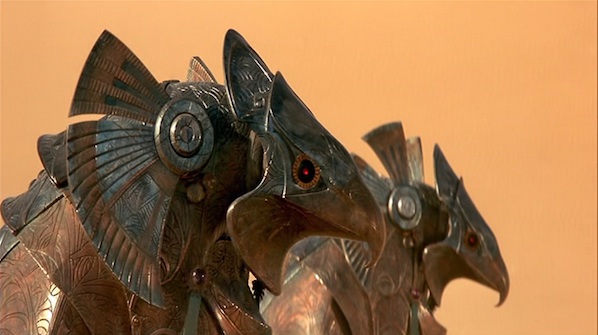
I referred to Ra’s armored guards as Jaffa for lack of anything better to call them (the script identifes them as Anubis and Horus, interestingly enough). Their stomachs are bare (as are many of Ra’s palace subjects) with no sign of the X-shaped pouch for a larval Goa’uld.
The characters of O’Neil (spelled O’Neill in the series), Jackson, Kawalsky, Ferretti, both Doctors Langford, Sha’re, Skaara, and Kasuf will all reappear in the TV series, all but the last two recast. Ra and West will both be referenced again, but not seen. While the technicians who operate the gate are all civilians in the film, it will be consistently operated by Air Force personnel in the series.
Three of the actors in the film will return on TV. Alexis Cruz and Erick Avari will reprise their respective roles as Skaara and Kasuf throughout SG-1, while Richard Kind, who played one of the linguists, will return in two episodes of Atlantis as Lucius Lavian.
Chevron seven locked. On the one hand, this really isn’t a very good movie. There are some nifty ideas here, but the actual plot is pretty dire.
On the other hand, it makes a dandy pilot for a TV show that can take those nifty ideas and flesh them out. It’s to the credit of the TV producers that they took all the elements that Devlin and Emmerich threw at the wall and made a really impressive tapestry out of them.

Still, there isn’t much to like here. James Spader is certainly charismatic enough (I actually watched an episode of The Blacklist before watching the movie, not to mention seeing the latest Avengers: Age of Ultron trailer, and his voice and his ability to use it to good effect really is amazing, and has remained so for two decades), but ultimately this is pretty much the same plot as half the B-movies of the 1940s and 1950s with better special effects. The hard-bitten military dude teamed up with the wimpy scientist who just wants everyone to get along was a cliché when we saw it in the first Hulk comic book in 1962, and it didn’t age well into the 1990s. John Diehl’s Kawalsky and French Stewart’s Ferretti were actually more interesting characters than the nominal lead, as Kurt Russell just phones in his performance here, bringing no subtlety to a role that’s supposed to be a person in pain, and instead comes across as a person who needs an antacid.
There’s no strong sense of characterization here. They’re not people, they’re clichés, and they’re fulfilling their appointed role in the cliché handbook to the letter, from O’Neil’s unconvincing new lease on life to Jackson’s sudden bravery to all the Air Force guys who don’t get billing being killed to O’Neil’s “give my regards to King Tut, asshole,” which is such a painfully constructed catch-phrase that you just want to vomit. The notion of the gods of Egypt (or at least one of them) being an alien is an interesting one, but the movie doesn’t really do anything with it beyond an excuse to dress Jaye Davidson up in snazzy period outfits.
The beginnings of the TV franchise are all here, and it’s to the credit of Jonathan Glassner and Brad Wright that they saw the potential. But this movie itself is pretty nowhere.
Keith R.A. DeCandido is currently working on a Stargate SG-1 novel entitled Kali’s Wrath, which should be published later this year by Fandemonium Books. His SG-1 short story apppeared in Fandemonium’s first Stargate anthology Far Horizons in 2014.










